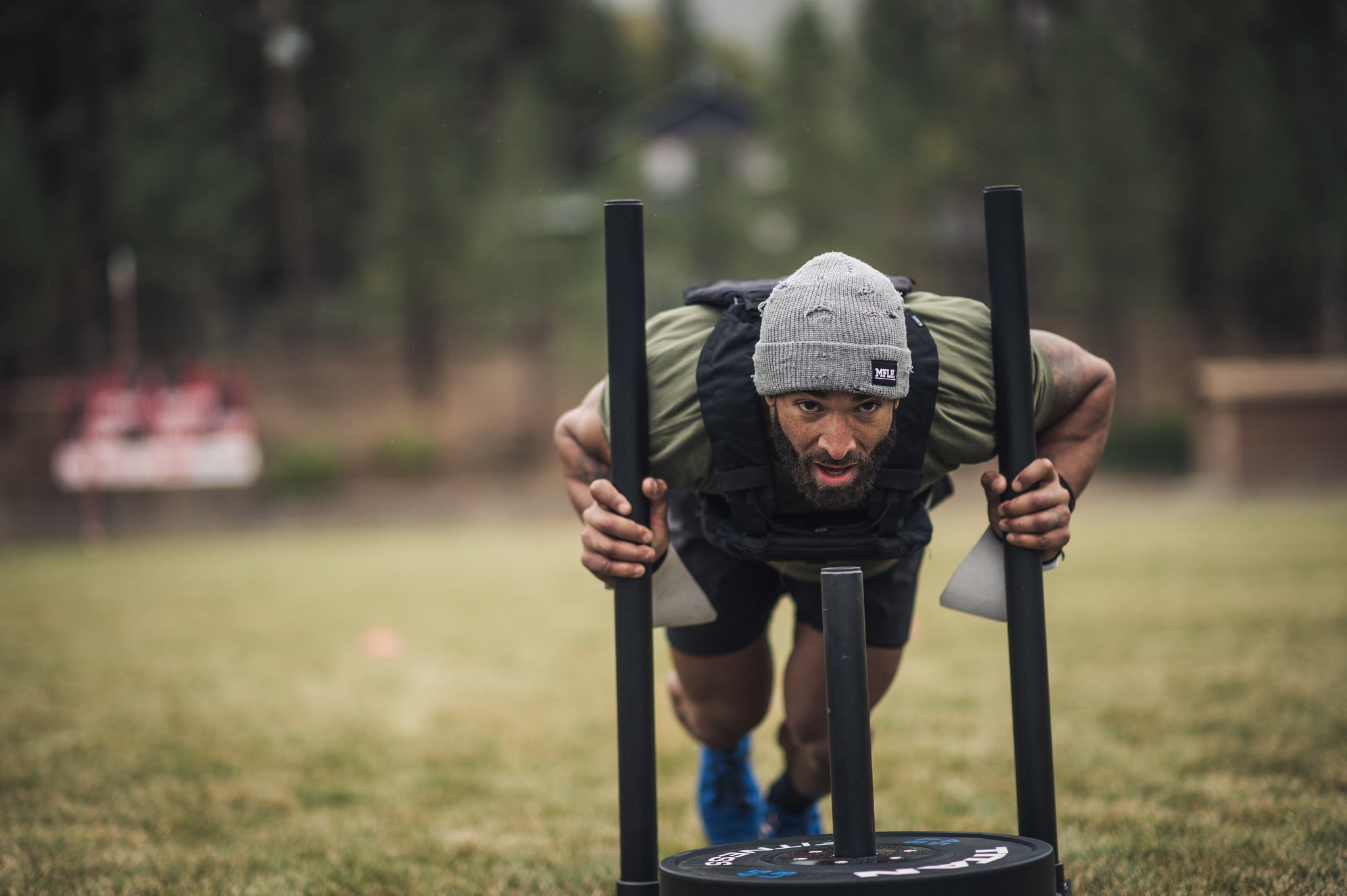3 Benefits of Adding Weighted Sleds to Your Weekly Training

Sled training is one of those terms that can have multiple meanings to different people, similar to “interval training” or “strength training.” You can push or pull a weighted sled, or you can attach a weighted sled to yourself with a harness and sprint with it. We do a little bit of everything with them.
The Spartan Sled Unit of Choice
When working sled workouts into our weekly training, we opt for Titan Fitness' Pro Sled Unit. It's a highly versatile piece of equipment that you can push, pull, or drag. There are 2-inch side hole spacings on the skids which allows you to add a variety of mountable accessories like the High/Low Bar, Lawn Boy, and Wrap-Around Rail. The unit is high-quality, yet at an affordable price, and makes for an easy at-home gym addition for building speed and agility. Turf or grass is the ideal surface for these, but they can also be used on concrete.
What Are the Benefits of Sled Training?
Pushing a sled forward is an exercise that can be used to improve sprinting performance, burn calories, and build strength in the quads, hamstrings, and calves without any eccentric (negative) force, such as landing during running.
One study found that pushing a sled improves sprinting performance more than sprint training without weights. The most gains were made during the first 5 meters, and started to wane after that. Another study compared the back squat with a sled push exercise for muscle activation, and found that the squat works the lower back more while the sled push activates the calves more. Interestingly, the use of the quads, hamstrings, and abdominal muscles was similar between both exercises. This can be especially useful for Spartans that are unable to incorporate squats into their training due to past injuries.
Related: The Interference Effect: Do Cardio and Resistance Training Conflict?
How Effective Is Resisted Sprint Training?
Most of the research on sled training is actually on resisted sprint training using a sled (sled towing), a technique similar to resistance sprinting using bands or a wind parachute. A Sports Medicine meta-analysis of sled towing found that sled training is especially beneficial in the acceleration phase — the first 10 meters — but overall, the results are similar to just doing regular sprint training. (This is probably due to the fact that study participants rarely used loads greater than 20% of their body weight.) With that said, resisted sprinting is used to increase stride length and speed strength by increasing ground force production.
Another study looked at the biomechanics of resisted sled towing using 12.6% body mass (BM) and 32.3% BM and found that the lighter load caused fewer changes in stride length, whereas the heavier load causes more shoulder joint movement. Therefore, it’s suggested that for sprinters working on acceleration, using a heavier sled can help them generate more force using their arms. Essentials of Personal Training suggests that loads that decrease regular sprint performance by more than 10% are too heavy (known as the “10% rule”). An acceptable way to gauge load is to start with 15% of the person’s body weight.

But there seems to be a trend toward investigating heavier loads for improving sprint acceleration, which is crucial in Spartan races, especially when getting a running start before wall jumps, climbing stairs and sprinting through corridors during Stadions, and quickly pushing a sled during DEKA competitions. In a Journal of Strength and Conditioning (JSCR) study, study subjects did sled sprint training for eight weeks using a load that decreased regular sprint performance by 30% (heavy) along with a load that produced the standard 10% decrease. Not surprisingly, the heavy load improved regular sprinting time in a 5-meter sprint more than the lighter load. And researchers in yet another JSCR study determined that a 20% BM sled load improved ground reaction force more than a 10% BW sled load or unresisted sprinting.
Related: These 3 Explosive Fitness Tests Will Expose Your Athletic Weaknesses
The last motion to discuss is sled pulling, where you attach a rope and/or handles to a friction sled, stand facing the sled, and walk backward as you pull it. Sled pulling is becoming more common in the physical therapy setting because when you step backward, you’re extending the knee. This is a way to improve terminal knee extension in a more functional way than using a resistance band or cable machine. Terminal knee extension requires contraction of the quadriceps, especially the vastus medialis oblique (VMO), which typically have decreased strength after a knee injury such as an ACL tear or patellofemoral syndrome.
Sample Sled Workouts

Whether you’re pushing, pulling, or towing a sled, aim for 10-30 meters at a time. Sled training doesn’t mean that all you do is use a sled while working out, but try to incorporate sled training one or two times per week for eight weeks to start.
Sled Towing or Pushing Sprints
Sets: 2
Duration: 20 meters x 3 trips (60 meters each set)
Total Distance: 120 meters (about 2 football fields)
Rest: 4 minutes between sets
Sled Pulling
Sets: 4
Duration: 10 meters
Total Distance: 40 meters

